
General advice from Company Seven about Selecting the SBIG
Models ST-4 through ST-8 CCD Autoguide and Imaging Systems
July 1997
We appreciate your interest in our Santa Barbara Instruments Group (SBIG) Charge Coupled Device (CCD) systems. The SBIG integrating CCD systems are the most popular of our CCD products. The SBIG Model ST-4 CCD system opened the field of scientific imaging to many users; it has become the most successful automatic guiding system we have made available to the advanced amateur or institutional user. For $990, a user now has a reliable portable system that can guide a telescope with a precision that cannot be matched by an average human, or capture the image (with an optional PC or Macintosh computer) of an object. The ST-4 has proved to be so successful with the amateur and professional community, it is employed at many amateur and professional observatories including the Mount Palomar 9"f15 refractor guiding telescope on the astrographic 48" Schmidt Camera telescope.
Continuing a pattern of innovation, SBIG followed the ST-4 with the larger and more sensitive ST-6 (which in 1996 was supplanted by the improved Model ST-6A) imaging camera. The ST-6 series has been reviewed in magazines such as "Sky & Telescope" with such favorable conclusions that it has been suggested that affordable high performance CCD imaging has now arrived with the introdcution of the ST-6.
CCD systems such as these allows one to observe the otherwise unobservable and to display, enhance, and evaluate the data in a wide variety of ways. Even from suburban skies, the CCD owner can view the unimaginable! With a modestly priced, simple to operate camera such as the SBIG Model ST-5C/Celestron "Pixcel 255" camera one can now capture, and then integrate three filtered CCD images to produce color images of planets and deep-sky objects! Reduction of atmospheric turbulence effects through image processing open entirely new possibilities to lunar and planet observers; the new adaptive optics technology (usable only with the SBIG Models ST-7 and ST-8) announced and demonstrated at the SBIG CCD Imaging Conference in July 1996 is the next evolutionary milestone in astronomical imaging technology advancement. In a sense, it is as though you have added "instant aperture" to your telescope! The SBIG systems have become so well accepted in the community that we have seen the community develop other applications for these cameras and their variants; some of which were not originally viewed as possibilities by SBIG. These applications include use as an imaging Photometer, and as a detector for Spectroscopy from infrared into the ultraviolet. Other proven uses include photometry, red shift measurement, and blink comparison to name a few of the astronomical applications; many other sciences have applied the SBIG technology including medical and art conservation!
There are several aspects of CCD cameras to understand when one is contemplating such an acquisition:
The primary determinant of the actual field of view of a CCD imaging
system is the effective focal length of the optical device (telescope,
camera lens, microscope, etc.), and the dimensional area of the CCD
detector. The larger the detector is, then the larger will be the field of view that one can capture with a lens system of
similar effective focal length. One can predict the actual field of view in degrees to be
imaged with the following formula:
- 57.3/Effective Focal Length of Objective (mm) * dimension of CCD
chip.
For an example; the SBIG Model ST-4 camera incorporates a Texas Instruments Model 211 CCD detector chip of a 2.62mm square. If employed on a 1000mm telescope, then this will yield an actual field of view of 0.15 Degrees.
To demonstrate this concept, study the following illustration to see how the relative areas of sky coverage change for several of the popular SBIG astronomical imaging cameras.
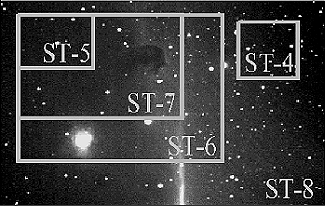
Illustration 1. ST-6 Image by Thomas M. Bisque using 4" TeleVue Genesis SDF Telescope f/5.4
While a larger CCD detector area is generally desirable in deep sky astronomy, for some applications it may have little importance such as if imaging apparently small objects such as the Planets. And other factors such as pixel size, or computer storage a nd processing capacity, or the availability of image processing software and output devices may have some bearing in selecting the best CCD for a particular users needs.
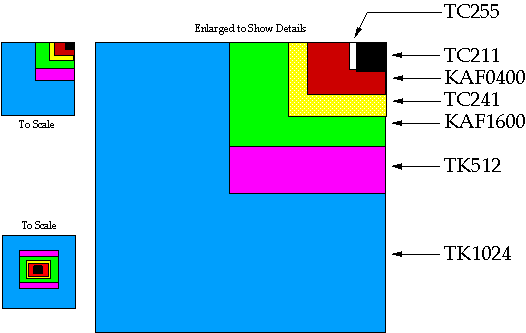
Illustration 2. Relative Sizes of Common Astronomical Imaging CCD's
The ST-6A is available with (or can be upgraded) to the ST-6I for spectroscopy. This version differs from the standard ST-6A only in the ROM and software functions which are designed with spectroscopy applications in mind. Furthermore, another CCD system based on the ST-6A is the ST-6V. The ST-6V includes all the features of the ST-6I, but the chip and optical window offer increased sensitivity of the system into the ultra violet to below 200nm.
Continuing their tradition of innovation, SBIG then introduced two new cameras with an unique concept (Patented) for astronomical imaging. These are the Model ST-7 and Model ST-8 cameras each of which contain two CCD's arranged in parallel; a Kodak KAF0400 for imaging (ST-7) or a Kodak KAF1600 (ST-8), and a Texas Instruments TC211 detector for tracking. This truly was the next evolutionary phase of astronomical CCD imaging!
The two CCD's are mounted onto a common pedestal on top of the thermoelectric cooler within the CCD head housing. These CCD's share an Analog to Digital converter, and other readout electronics. In operation, the TC211 portion of the CCD camera detects a star slightly outside the field of view of the Kodak imaging CCD chip, and it generates the signals which then drive the relays thereby adjusting the telescope tracking. The geometry of the Model ST-7 is illustrated in Illustration 3. The ST-8 is similar in arrangement however, the imaging CCD area is larger than that of the ST-7.
The TC211 is identical to the chip used in the popular SBIG Model ST-4/4X guiding systems, and in practice the ST-7/ST-8 tracking technique is very similar to the ST-4, except the ST-7/ST-8 integrated concept has evolved to allow the TC211 to acquire and guide on fainter stars. In practice, up to the evolution of these cameras users have employed two separate CCD systems; one for guiding and another for imaging. And up to the time of introduction of the ST-7 and ST-8, no one else has rendered it successful within one single head thereby allowing quicker and easier setup and operation, less complicated cabling, and simpler computer and power requirements. And to this day, these cameras remain technologically without equal.
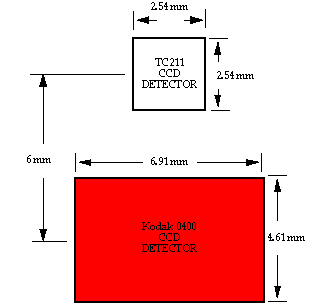
Illustration 3. The Chip Arrangement within the Model ST-7 CCD Head
In the Models ST-7 and ST-8, both of the CCDs focus at the same point (are parfocal), and their apparent separation is only 6mm center to center. One might expect this arrangement would make composing the image while simultaneously centering a guide star while imaging some objects would be contradictory. SBIG conducted a test where it was determined that the probability of finding a guide star by random luck as a function of the brightness of the guide star. The tests involved imaging 50 fields, chosen at random, widely distributed over the Coma Berenices constellation region with an ST-4X at the prime focus of a 10" telescope operating at f6.3. The results are presented in the following Figure 3:
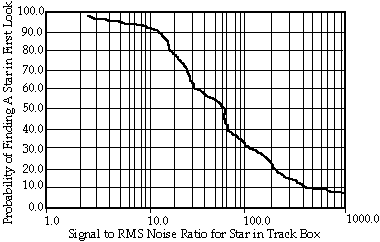
Illustration 4. Study of Probability of Finding a Guide Star Using a 10
Second Exposure
(Very close approximation drawn from SBIG data)
The advantages of self guiding, particularly when Track and Accumulate works fairly well, are that self guiding will produce images with better signal to noise ratio, particularly when doing color imaging since then the sky background is lower. One will not have to make one pixel shifts when adding images together, so the resolution will be better on tightly focused stars. Most importantly, the tracking corrections can occur twenty (20) times more frequently, thereby improving the tracking accuracy of most drives. It has been our experience that few telescope drives would permit unguided imaging exposures of longer than one minute on a ST-6, which has pixels three times larger than those on a Kodak 0400 CCD.
The other advantages of self guiding over a stand alone guider are many; differential deflection between the guide telescope and imaging telescope is eliminated, and set up time greatly reduced. The advantage of this concept also involves cost and complexity; a CCD system with a comparable imaging detector chip bundled with a separate CCD system employed as a guiding CCD with a guiding mechanism such as a radial off axis guider assembly or a seperate guide telescope is considerable in cost and complexity. Aside from a price difference in fa vor of the dual chip cameras such as the ST-7, the ST-7 or ST-8 will acquire a guide star in a quick and less complicated manner.
The sensitivity advantage of the SBIG ST-7 and ST-8 systems over the prior generations of systems still marketed is enormous! For an example, one maker of a CCD system employing the KAF0400 detector claims their product will guide on an 8th magnitude star (telescope aperture unspecified). The ST-7 self guider will follow a star fainter than magnitude fifteen (15) with a 10 second exposure with a 10 inch (25.4cm) aperture. The sensitivity advantage improves the density of available guide stars by about 100 0 times!
In evaluating the performance of the ST-7 and ST-8, we have found them to generate imagery that is truly remarkable. It has been determined that carefully guided exposures exceeding one hour are possible, this enables a telescope such as the Celestron C-8 to capture images of stars as faint a Magnitude 19 from typical suburban backyard observing sites. Tricolor images done by Mr. Benoit Schillings using an ST-7 with a Celestron 8 telescope at Los Altos California in 1995 of the Dumbbell Nebula (M27), and the Trifid Nebula (M20) are on display in our showroom; these at the least rival those best images ever captured on film with the C-14 telescope! Realizing how the technology has advanced, we find more and more of our customers who have an interest in CCD imaging (particualrly from suburban environments) are spending less on the telescope and more on the CCD camera; sometimes by a factor of 2X to 6X!
The esthetically pleasing images come at some expense however, as the KAF 0400/1600 series CCD's are not as responsive (Quantum Efficiency) as the TC-241 series furnished on cameras such as the ST-6 series across the spectrum. Eastman Kodak is working on new generations of detectors, with improved spectral response but to date, these have limitations that preclude their use by SBIG. The lower sensitivity of a chip may be made up to some degree with a longer exposure time. But, the response of the KAF chip is particularly low into the blue portion of the spectrum. This poses concerns for those who need a detector with a more efficient or uniform response across these areas of the spectrum therefore, we continue to recommend came ras such as the ST-6 for certain scientific applications over the KAF series. For those persons who intend to use the KAF series for tricolor imaging, then they are advised to increase their exposure times in the blue markedly over those taken in the Red and Green, and the use of color balancing software will be highly desirable. The following table indicates the spectral response of the KAF 0400 and TC-241 CCD's from the ultraviolet at 400nm to the infrared at 700nm.
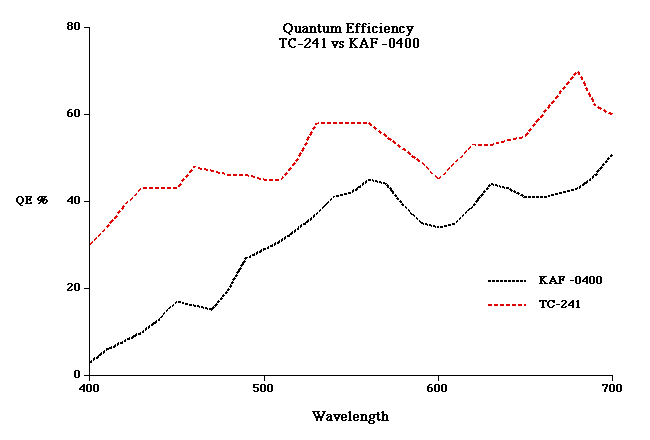
The ST-7 and ST-8 utilize a CCD detector with nine micron square pixels plus on-chip binning to support 18 micron pixels, this is for improved image quality with longer focal length telescopes.
Finally, the tracking function of the ST-7 and ST-8 is controlled from the computer keyboard. The user will see the star field on the computer monitor, then select the guide star with the cursor, and optimize the exposure time and tracking parameters. The computer can perform an accurate drive calibration no matter what the orientation is of the chips within the CCD camera head.
With the Model ST-7 and ST-8 dual CCD self guiding imaging cameras there are two choices that a customer must make. These two choices are imposed on SBIG by the Kodak detectors designed into these instruments by SBIG. All customers must decide if they desire an antiblooming function or not, and if they want a higher grade of CCD detector than that normally furnished.
A. Blooming in a CCD occurs when the full well capacity of the pixel is exceeded and this appears as a streak below bright stars. The length of the streak is proportional to the overexposure of the stellar image. The Texas Instruments CCD's used in the ST-4, ST-4X, ST-5C, ST-6, ST-6I and ST-6V incorporate an antiblooming gate control that can be enabled through the SBIG control software. In the Kodak CCD's this function is implemented by a metallization grid that is applied over the pixel structure and, therefore, each user must select whether they want this function included with the CCD detector at the time of manufacture. Several factors should be considered in deciding whether or not antiblooming is desired, these are as follows:
1) Sensitivity: the metallization grid on the Kodak detectors block 30% of the area of each pixel. As a result, the CCD is only 70% as sensitive as the version without antiblooming. CCD images are typically limited by the noise in the sky background, though, so that the net result of this reduced sensitivity is a 16% higher noise level in the image. This is not visually too noticeable, and it can be eliminated with a 40% longer exposure.
2) Full Well Capacity: the Kodak CCD detector without antiblooming is linear (electrons per unit of light) up to 80,000 electrons per pixel. The CCD detector with antiblooming becomes nonlinear at about 40,000 electrons per pixel. This will become apparent to users doing photometry on bright stars where the photometric data may not be accurately saved.
B. Kodak offers several classes of CCD detector chips. In the Model ST-7, SBIG will furnish a Class 1 chip. In the Model ST-8 SBIG will furnish at least Class II. Additionally, SBIG will furnish special software with each ST-8 to remove the 2 dead pixel columns from all images taken with that camera. If the customer wants to have an ST-8 furnished with a class I CCD detector chip, then that can be provided for an upgrade cost of $1,900 (U.S.). The characteristics of each class are:
- Class I: No dead columns, no cluster defects, and less than or equal to 5 point defects.
- Class II: Less than or equal to 2 dead columns with none in the
central half,
less than or equal to 4 cluster defects, less than or equal to 10 point defects.
As a general rule, Company Seven and SBIG are recommending the Kodak CCD detector with antiblooming control to most of our clients. We have learned that most users who desire the most pelasing images prefer antiblooming structures on their CCD detector. And so, the standard detetor will be provided "with ABG". However, we will continue to offer "non ABG" as an option.
Among the reasons we at Company Seven continue to believe the SBIG systems offer a great value and performance is their constantly evolving and expanding software features, as well as hardware options for these systems which are designed to be tailored to meet the actual needs of the end user. I hope you will find the SBIG material we offer interesting and exciting; this best serves to illustrate how improved the quality and afford ability of this emerging technology is.
To accept an order for delivery by mail or common carrier, the payment is usually forwarded to us before shipment of the order. The most convenient form of payment for our customers is cash, check, or with a VISA or Mastercharge credit card. We will bill the card for product only as it is picked up at our showroom or shipped. Company Seven will also accept payment by International Money Order, Wire Transfer or Western Union (inquire for routing instructions).
Customers are not liable for sales tax when the item is delivered out of state by legal common carrier, so there are no applicable taxes (State, Federal, etc.) on this order. Small package international orders are shipped by Air Mail unless the customers specifies another common carrier (Federal Express, United Parcel Service, for example - if you have a corporate account with one of these carriers we may be able to bill the costs to your account number if you provide it). The freight charges and any import or customs fees are borne by the customer. For your information, the shipping weight of the ST-4 is about 4.2 Kg., the ST-5C is 5 kg., the ST-6A/ST-7/ST-8 is 5.5 Kg.
We ask all orders include mailing and shipping address, and telephone numbers of the product user for our records. Our SBIG ST-4, ST-4X, ST-5C and ST-6A CCD systems operate from 12 volt D.C. or from the provided 120 volt A.C. to 12 volt A.C. transformer. The ST-7 and ST-8 systems require 12 volt A.C., and 115 volt A.C. power supplies are furnished. However 12 volt D.C. power supplies are optional, and 220V A.C. versions are now available on special order but, power may be also be provided by an optional regulated D.C. power supply from A.C. to 12 volt D.C. One could therefore operate any of these systems from a rechargeable 12 volt deep-cycle Marine or Recreational vehicle battery, or with a transformer from overseas curre nts.
I hope this brief introduction gives you an opportunity to better understand these systems, and if this has not answered all your questions then at least this will have served to better focus any further inquiries. Should you have any further inquiries on matters pertaining to the design, specifications, instrument and accessory applications, or procurement, then you are most cordially invited to call or communicate by facsimile to 301-953-2000. Or, if you find the opportunity to be near Washington, D.C. or Baltimore, or you are welcome to visit our showroom located at 14300 Cherry Lane Court, Laurel, Md. Our facility is open on Mondays through Friday 11 am to 6 p.m., and Saturdays 11 a.m. to 5 p.m. (Eastern Time), and is closed on Sundays and on U.S. Federal Holidays.
Sincerely,
Martin C. Cohen
Division Director
Contents Copyright 1994-2000 Company Seven - All Rights Reserved

